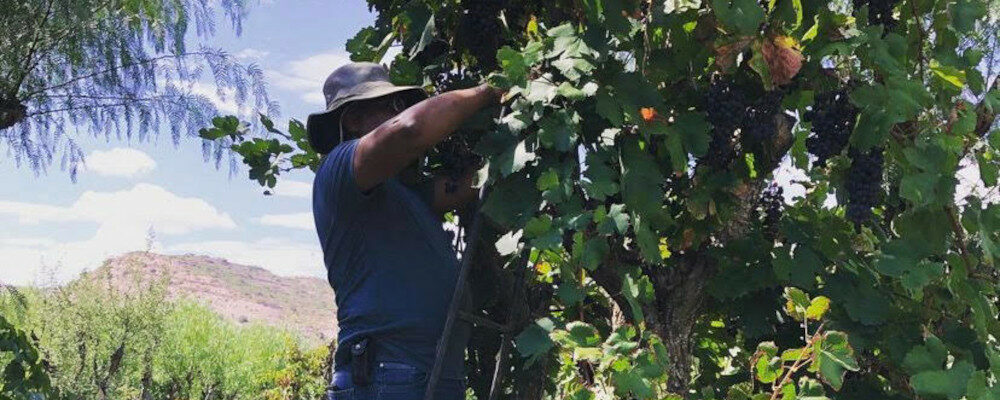Jancis Robinson once called Nayan Gowda a “winemaker without portfolio” in a profile piece that tracked his prolific career as a winemaker and consultant across continents. That was in 2013, and when I met the dapper Englishman on a press trip to the Loire Valley in 2019, the man who had both at one point been a chef at The Ivy in London and then worked in IT for JP Morgan had gone back into tech as the publisher of the world’s largest winemaker job board. Except, he had one more project on his horizon: a winemaking gig in Bolivia.
The temporary job in Bolivia turned into a South American COVID lockdown and the one harvest he’d gone there to manage turned into two. Mr. Gowda seems to have put down roots at Jardín Oculto, the winery in the Cinti Valley. The name translates as “Secret Garden”. The latitude there is 20 degrees, or ten degrees closer to the equator than the normal limit for growing the vitis vinifera grape,1“Vitis vinifera, the common grape vine, is a species of flowering plant, native to the Mediterranean region, Central Europe, and southwestern Asia, from Morocco and Portugal north to southern Germany and east to northern Iran. There are currently between 5,000 and 10,000 varieties of Vitis vinifera grapes though only a few are of commercial significance for wine and table grape production.” https://en.wikipedia.org/wiki/Vitis_vinifera but the valley is in Bolivia’s high desert plains. The average elevation of the vineyards in the valley is 2,000 meters above sea level, making it cool enough, especially at night, to grow fine wine grapes in what is essentially a river oasis in arid land.
I had been following Nayan’s Bolivian winemaking and lockdown adventures by way of his Twitter account. I wondered if some strange twist of fate might get me in front of his wines at some point. Then, at the end of September, I noticed that he was posting from Turin in Northern Italy, which was precisely where I was heading the next day. A brief exchange established the good news: Nayan and Jardìn Oculto’s proprietress, María José Granier, would be at the Slow Food Terra Madre Salon del Gusto 2022—with the Jardín Oculto wines.
A few days later I bumped into Nayan at Terra Madre one morning in one of the busy tents full of regional Italian foods, where we were independently (and greedily) sampling as much cheese, salumi, and whatever else was on offer. He explained that Marìa José was on a panel discussion early that afternoon and then their wines would be part of a structured tasting that evening. When I complained that I waited too late to get tickets to the sold-out tasting, he said that was fine because he had extra bottles and would be happy to taste the three wines he had brought to Italy with me at the enoteca that afternoon.
When I ran into Nayan Gowda, I was in the company of my Calgary colleague, the journalist Shelley Boettcher. When I introduced them and explained in vague terms what he was up to in Bolivia, Nayan brought out his phone to show us pictures of the vineyards. Except they didn’t look like any vineyards I had ever seen. The vines, planted in the 19th century by Franciscan and Jesuit missionaries, were trained to go up trees, and interplanted with all kinds of other fruits and crops. Picking the grapes requires a ladder, and the fruit that the pickers can’t reach is literally left for the birds.
María José Granier’s family, Nayan explained, are established winemakers in Bolivia but had only heard and seen San Roque, the vineyard on his screen, a few years ago. María José took on Jardín Oculto as a next-generation project in 2019 and went on Nayan’s Facebook group to find an oenologist2“Oenologists are the professionals who supervise not only production in the winery but also the storage, analysis, preservation, bottling and sale of wine.” https://www.bodegasmontecillo.com/en/what-is-an-oenologist-and-how-do-you-become-one/ who wasn’t afraid to do something different. Having made wine in such exotic locations as Kazakhstan, Nayan answered the request himself. The wines we were to taste from the 2021 vintage were made after his first vintage in 2020.
We found an empty table in the outdoor seating area of the enoteca. The wine pavilion at Terra Madre was stocked with over 400 wines to taste, all from Turin’s home region of Piedmont. A few other Terra Madre delegates who were hanging out in the enoteca joined our group and we stood in a semi-circle around Nayan who introduced the wines from Jardín Oculto’s San Roque.
First up was the 2021 Vischoqueña Blanc de Noir. Vischoqueña is an “indigenous grape”, in so far as it’s not found outside of this particular area of Bolivia. Nayan is trying to figure out its parentage and where it may have come from, but for now it’s a bit of a mystery. Blanc de Noir refers to the technique of making a white wine from red (or black) grapes. It’s most often used for sparkling wines, though Jardín Oculto’s version is a still wine.
Nayan explained, as we swirled, that Vischoqueña typically makes an oddly aromatic red wine, so his intention with the white version was to make a more straightforward “linear” sipper where the fruit was left to “do its thing”. It was lovely, crisp, and mineral with citrus and tart McIntosh apple notes. An aperitif wine that brought water to the mouth.
Next up was the 2021 Moscatel de Alejandría. Muscat of Alexandria is the most common version of this aromatic white grape, which was spread around the Mediterranean, including their kingdom in Spain, by the Moors who prized it as a table grape. Often made in a sweet style, it’s not always my favourite. So I was very pleased to find that Nayan and María José’s wine was subtle in white flower aromatics and lime citrus and a slightly bitter dandelion finish.
Our last Bolivian tree wine was Jardín Oculto’s red, the 2021 Negra Criolla, made from the single Los Membrillos vineyard. When one thinks of South American reds, it is hard not to imagine warm-climate, powerful, and big fruit wines from Bolivia’s southern neighbours.
The Negra Crollia, made with the Spanish grape that is often called Criolla Chica in Argentina, País in Chile, and Mission in California, was light-footed and a little spicy. Red cherry notes underlay a touch of smokiness and seasoning of pepper. When I gave my pepper note to María José, she laughed and said that the vineyard included a pink pepper tree.
Production is still very small at Jardín Oculto, hampered still by the pandemic and supply chain crisis. But Nayan Gowda and the Granier family are forging on and looking for export markets, even just for pride of placement. Canadian importers take notice: the market for Bolivian ladder-picked, old-vine tree wine is wide open.




